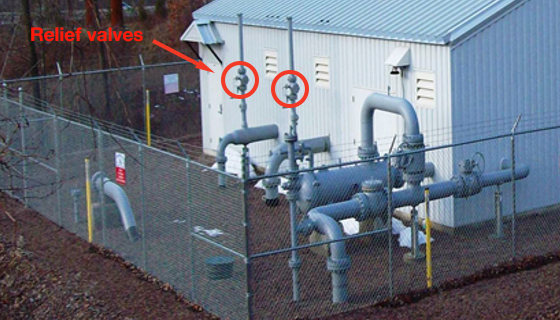|
Welcome to National Grid’s Tips of the Trade for first responders. These tips are intended to help you respond safely and effectively to incidents involving natural gas and electricity. Please review them with your team.
|
|
| Relief valve safety |
|
 |
| Engineered to vent excess gas and vapors from natural gas pipeline systems, relief valves can produce startling discharge sounds, odorants and vapor clouds when actuated – even in normal operating conditions. Understandably, these discharge signs may be met with public concern. Read on to learn more about relief-valve behavior and safety and about how to keep your community safe and informed. |
|
|
|
| Be proactive |
| Relief valves are designed to protect pipeline systems from over-pressurization. Even a small release of natural gas through a relief valve, which may be a normal operating condition, will often result in community concern stemming from the smell of mercaptan. During any pressure release event, you should work with the utility to distinguish between normal and abnormal (emergency) situations.
|
| In any case, a natural gas event should not be your introduction to relief valves in the community you serve. Partner with National Grid preemptively to learn the location of these devices throughout the community. |
 |
| Dedicated relief valves are typically present in high-pressure distribution stations and at pressured storage locations. |
| Know how to respond |
| When relief valves actuate, notify the utility and request the response of a subject matter expert (SME) who should work in partnership with first responders as a member of the command team. Work with the onsite SME to: |
| • |
 |
Perform a predictive analysis of prevailing wind patterns and conditions to determine odorant and vapor-cloud migration. |
|
| • |
 |
Set up appropriate safety/exclusion zones and monitor critical areas. |
|
| • |
 |
Identify priority risks and target hazards, such as control stations, neighborhoods close to potential event areas, or highways that could be ignition sources. |
|
| |
 |
Important: NEVER enter control stations, and NEVER operate or change the settings of pipeline, storage or control station valves of any type. Only trained utility operators should open or close these valves. However, if trained to do so, you can stop the flow of gas by closing the aboveground shutoff valve at a service meter or the shutoff valve at an appliance line. |
|
| |
|
| Protect and inform the community |
Again, discharge sounds, odorants and vapor clouds can be alarming to the public – and rightfully so. Once the utility has confirmed that the event is nonthreatening: |
| • |
 |
Continue to take public concern seriously and choose a single-source contact for public communication, such as through some form of media. |
|
| • |
 |
Reassure the community about the behavior of the relief valve as a safety device operating as designed to relieve pressure from the pipeline system. |
|
| |
|
| If the relief valve continues to actuate for an extended period, the odorant released will likely cause community concern. Therefore, consider placing firefighting apparatus and utility resources in the area as a proactive tactic and a demonstraton of fire service presence to ease potential community concerns. |
| For more first responder safety information, visit firstresponder.ngridsafety.com. |